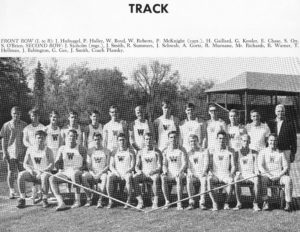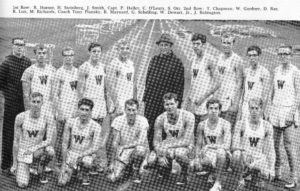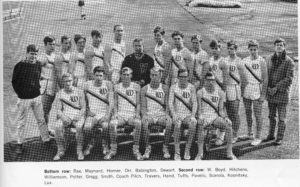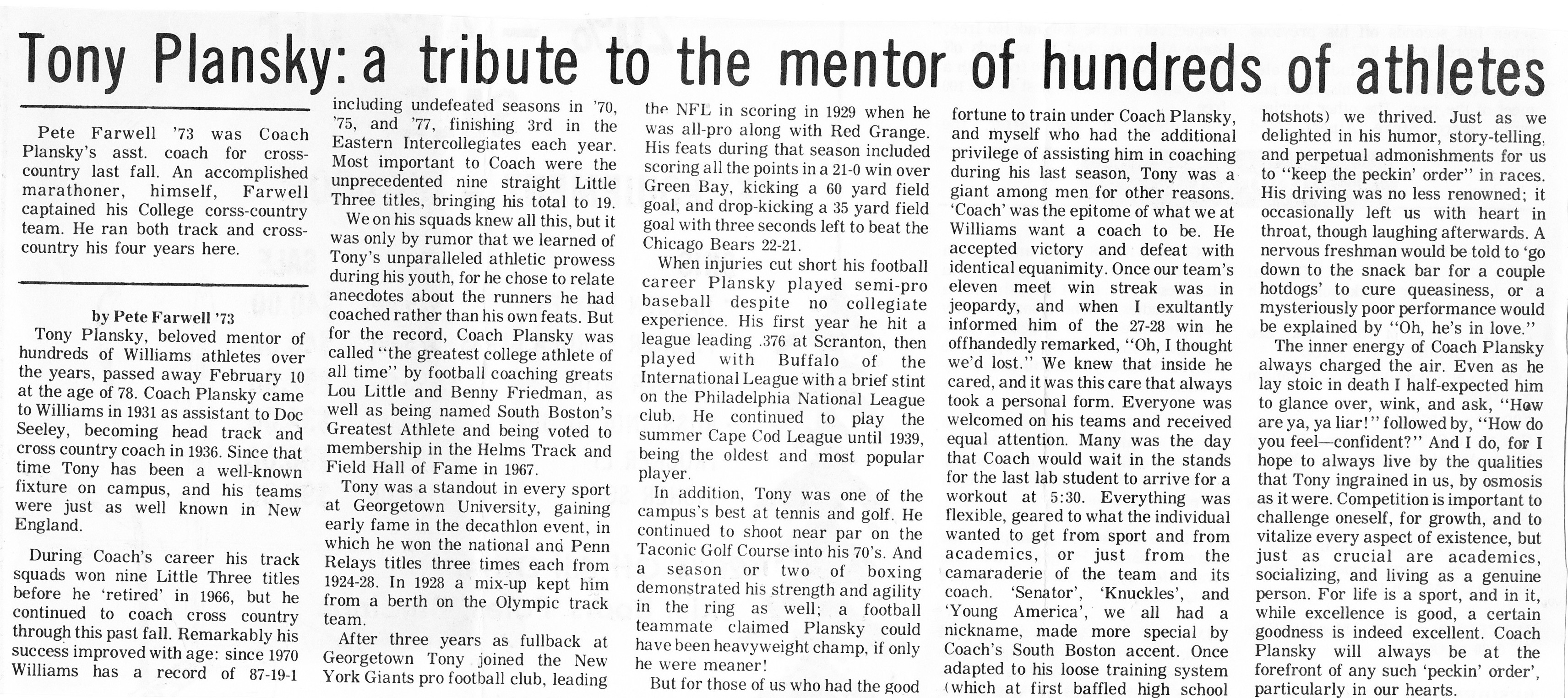 Editor’s note: Bob Lux organized this tribute, reaching out to classmates Rod Maynard, George Schelling, and Peter Naylor (who first proposed the tribute). Bob also contacted Pete Farwell ’73, track coach at Williams for many years. Pete’s comments appear as a scanned image of a 1979 article published in the Williams Record.
Editor’s note: Bob Lux organized this tribute, reaching out to classmates Rod Maynard, George Schelling, and Peter Naylor (who first proposed the tribute). Bob also contacted Pete Farwell ’73, track coach at Williams for many years. Pete’s comments appear as a scanned image of a 1979 article published in the Williams Record.
Phil McKnight ’65 also wrote a tribute to Tony, and we open with some biographical information about Coach Plansky from the archived version of the Class of 1965 reunion website.
Don’t forget to browse the photo gallery that follows the tribute.
Tony Plansky coached cross country and track at Williams through five decades, from the early 1930s to the late 1970s. Williams named its running track for him, and it hosts the Plansky Invitational cross country meet every fall. His own phenomenal sports career may have been unknown to most of the student athletes he mentored, but the story needs to be told.
In 1999, Sports Illustrated named Tony Plansky the “best all-around athlete” in Massachusetts history. Lou Little, the legendary football coach at Columbia and before that at Georgetown, called Tony “the greatest college athlete of all time.” He was named South Boston’s Greatest Athlete, and was voted to membership in the Helms Track and Field Hall of Fame in 1967.
Coach Plansky was born in 1900 in South Boston and attended Georgetown University, where he played halfback, and also ran track. Throughout his career he mastered multiple sports. Tony played professional football for three seasons in the early 1930s (for the New York Giants and the Boston Braves, before they became the Washington Redskins) and minor-league baseball during the same years.
For the Giants he led the NFL in scoring in 1929 when he was all-pro. He was a fine tennis player and a tournament-level golfer and did some amateur boxing as well. Even more amazingly, in the late 1920s Tony was national champion of the decathlon for three years! He also won the Penn Relays titles three times. The decathlon—ten different events, from sprints to distance, high jump and pole vault to discus and javelin—is the ultimate, punishing event in track and field, or in any sport.
Sadly, a mix-up deprived him of a position on the US Olympic track team in 1928.
Tributes from members of the Class of 1968
Rod Maynard
Editor’s note: we’ve preserved Rod’s preference for lower case text.
a couple of thoughts about coach plansky.
first, what a nice guy. (i wish i could come up with a more descriptive word than “nice”). but running for him for all 4 years and a couple indoors and a couple outdoors, i don’t have one bad memory which comes to mind.
as you know, he was not high-powered. not a lot of “rah-rah,” but that wouldn’t have worked for me and, i guess, most of us. running is pretty self motivational and he understood that.
i do remember him coming to practice on that bike of his – which always intrigued me because he had hooked up a gasoline motor which he could turn on to help him get up the hill to the south campus from his house.
also, he never wanted to talk about his “glory” days as an athlete at georgetown, as a world recognized decathlete, as a pro football player. also never seemed to have bitterness about having a gold metal “stolen” from him – as i remember (might have to ask pete the particulars) in the 1928 olympics.
also, remember him always asking us – as we sat on the fence after warmups – whether we were going to have a “silly” coming up for the weekend. if one answered yes, he would always say that it now was a foregone conclusion for a poor performance – despite our protestations.
my fondest memory was fall senior year. i had an 8 o’clock class and then not one until 11. in between i would get in a morning run and would head for the golf course. i would always find him walking/playing there (with a bag that had 4 clubs) and we would just chat for 10 minutes or so – about the practice for the day, an upcoming meet, how somebody on the team was doing, what life was all about. it was a brief but significant part of my day, a meaningful part of that fall, and a subtle but integral part of my williams experience. i loved running on that golf course and i loved our daily chats.
also, one got the feeling that he really loved his wife betty; he was a good role model as to what a husband could be.
all in all, a good and decent man.
(Roger Maynard lived in Hopkins house, was a political science major, a member of Purple Key, and captain of the cross-country and track teams)
George Schelling
(as told to Dusty Lopez, a Williams grad, coach and compiler of
Williams track history)…
“There are some things that—I’m trying to recall whether I actually visually saw them myself or (whether they) were part of the Plansky lore.”
When visiting as a prospective student, Schelling got unknowingly paired with Plansky. “He was out there forever with me, looking for a golf ball in the woods. I had no idea until afterwards that here was this guy who was a renowned athlete and coach, and he was taking that time with me.”
Tony used a motorized bicycle—“I never saw him drive.”
“Part of the lore was, he was demonstrating to a bunch of us duffers how to throw the hammer. This was well into his advanced years. So he went out, he demonstrated, threw the darn thing, and he said, ‘now I think you’ll find that that stands up pretty well’—it had beaten the College record.”
“It was a wonderfully laid back time, because there weren’t many of us who participated. I mean, I threw the hammer, just because there weren’t three people who would throw it. I did the discus that way, I did the high jump that way. It depended upon who was around. And so it was sort of like volunteers to be in any one event. It was a delightful time.”
“It was such a privilege. There were great professors at the time I have wonderful memories of as well, but it was so interesting to see these guys, who were true gentlemen, who had a real perspective on college athletics, which is to say, they’re not supposed to overwhelm the rest of your life. Teaching us in such a relaxed fashion, where we all worked as hard as we possibly could, but it wasn’t sort of the modern sort of football coach approach.”
“It really added to the experience, because here was a guy who—he could’ve run circles, thrown circles, jumped circles, around any one of us.”
“It was entirely laissez-faire. You’d go to him for help, and otherwise, you’re kind of on your own. But I was never aware of anyone slacking off because we weren’t doing a series of 440s every day. He inspired us without a whip. My recollection is just going through my own routine and practicing, and then going to talk to him.”
“Very patient and painstaking. There’s this wry irony of this champion, who is guiding me, a total klutz… but you never got it from him. Never was there a sense of ‘Why am I wasting time with this klutz?’ It was just sort of like, we’re searching for the golf ball. That’s just what you do.”
“You would have no idea (of prowess) from the man himself.… I was never with him when he said a whole lot, about really much of anything. He was very friendly, but for me, he was a man of few words. He was just, by nature, more taciturn. That was still a time when everyone was still ‘Mr. Schelling.” … there was a little more distance.”
Why was Plansky’s retirement disappointing? “It was his gentleness and perspective on sport that seemed to be so consistent with the whole Williams experience. … He could get us to work as hard as we possibly could without being demeaning.” “it really has to be something you’ve really got it in you to want to achieve, and I think he appreciated that; he’d been there. He would give you the tools and the opportunity, and that’s all each of us wanted. If we were great athletes, we probably would’ve been somewhere else, doing something else.”
(George Schelling started in Sage and ended up in Spencer House, majored in American Civilization and ran track, played football (albeit briefly) and taught skiing)
Peter Naylor
Tony Plansky was national decathlon champion in 1924. He played professional football for the NY Giants and the Boston Braves 1928-1932.
So, he was quite an extraordinary athlete. When we knew him, he was in his sixties and walked with a limp. He coached track and cross-country. His style was very “laid-back”. He would lay out the program for the day and week and let us do it. If we needed guidance, he would give it, but he never pushed himself on us. There were some experienced runners in our class such as Maynard, Hamm, Lux and Perry, and some good upper classmen like Orr. I was a neophyte just training for hockey. We did well and we had more fun than you can imagine, running through the woods, when we weren’t being shot at by hunters.
Many years later, I was waiting at a car wash here in Santa Barbara talking to a stranger about good coaches. I mentioned Tony Plansky, and a young woman nearby spoke up: “Tony Plansky was my grandfather.”
Teachers having lasting influence.
(Peter Naylor studied Political Economy, resided in Lehman, Prospect, and Tyler houses, had a jazz show on WMS-WCFM, and played freshman hockey and cross-country)
Pete Farwell ’73
Longstanding successful coach of Williams track and cross-country, Peter wrote a tribute for the Williams Record in 1979. A scanned copy of his article appears here; click to enlarge
Bob Lux
As for me, Tony was one of those memorable mentors one luckily (and hopefully) crosses paths with on the long and winding road that is life. He was one who instilled valuable lessons in those who were fortunate enough to have known him.
Photos
Click to enlarge




